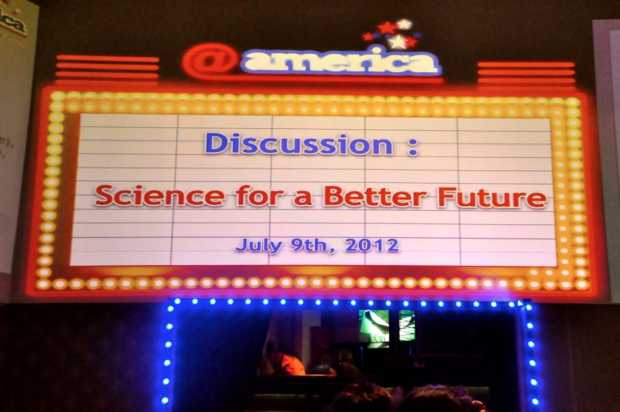Not a member yet? Sign Up!
Info
Please use real email address to activate your registration

A discussion on Science for a Better Future with three eminent American scientists, held last week in Jakarta, provided an opportunity for Indonesian students and young scientists to learn from the experts about the making of American scientists.
The three scientists, Dr. Bruce Alberts, Dr. Harold Varmus and Dr. Richard Beachy are in Jakarta to promote science cooperation and education between Indonesia and the United States.
@america
The venue for the discussion, @america center, represents a one-of-a-kind, high technology cultural center where visitors can explore, experience, and express their interests in the United States in fresh and exciting ways.
“Science is a systematic and logical approach to discovering how things in the universe work. Unlike the arts, science aims for measurable results through testing and analysis. Science is based on fact, not opinion or preferences. The process of science is designed to challenge ideas through research. It is not meant to prove theories, but rule out alternative explanations until a likely conclusion is reached” (LiveScience.com).
The definition given above was clearly illustrated in the @america discussion.
Dr. Bruce Alberts, a prominent biochemist, emphasized the importance of maintaining young generation’s enthusiasms in science. His interest in disseminating information is apparent in his service as editor-in-chief of Science.
Science is a historical periodical established in 1880 with money from American inventor Thomas Edison. It now becomes the world's leading publication for scientific news, commentary, and cutting-edge research reaching more than one million readers globally.
Dr. Bruce Alberts is one of the first “science envoys” under President Obama’s initiative to engage Muslimmajority and other countries through science and technology partnerships.
Nobel Prize
Such partnerships and scientific research for that matter require adequate funding. According to Dr. Harold Varmus, with enough funding scientists would be able to come up with evidence base thoughts. Dr. Harold Varmus is a co recipient of the 1989 Nobel Prize for Medicine for his studies of the genetic bases of cancer. Dr. Varmus, Dr. J. Michael Bishop and their co-workers demonstrated the cellular origins of the oncogene of a chicken retrovirus. This research was the precursor of isolating many cellular genes that normally control growth and development and are frequently mutated in human cancer. Dr. Varmus was nominated by President Obama as Director of National Cancer Institute and previously served as Director of US National Institute of health.
Scientists, according to Dr. Robert N. Beachy, do things that others have not done and leapfrog for knowledge. They also have to know what to do with their discoveries. Beachy specialized in plant virology and biotechnology of plants. He recognized the principles for the genetic engineering of plants that make them resistant to viral diseases. Beachy collaborated with a multinational company and started the world’s first genetically modified food crop, a variety of tomato that was modified for resistance to virus disease.
Inspiring scientists
All the scientists, except for Dr. Harold Varmus, have visited Indonesia more than 5 times, inspiring young Indonesian scientists, sharing their experience in science policy development, and fostering scientific collaboration and the exchange of ideas among Indonesian and American scientists in areas of mutual interest.
The eminent scientists agree on the notion that you need scientific skills in whatever you are doing and the more you know about different disciplines, the more you are able to answer questions.
Publish or perish
Although publish or perish has become an academic phrase and practice, where scientific publications demonstrate academic talent, the three scientists emphasized that work should not only be published but also be useful. Some scientists, for example, should know how their discoveries would be useful to a developing economy. Dr. Robert Beachy encouraged scientists to look at a map and see how their work might have impacts in certain areas. Beachy further elaborated on agriculture as knowledge based and technology based activities aiming at what can be done. An example is how to get crops with lower costs and higher yield.
The ethos of science
The three eminent scientists concur that what is exciting are what we do not know, and the ethos of science is to show evidence through socially based activities. Young people should ask questions and enjoy working in a laboratory; hence, experiential learning is necessary for scientists in the making.
--------------------
Photo by @america
Click to see the video of the discussion on Science for a Better Future http://www.ustream.tv/recorded/23875613